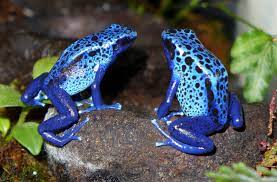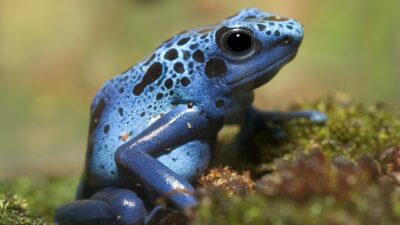When it comes to the vibrant world of amphibians, poison dart frogs are among the most captivating. Their striking colors and intriguing behavior make them a favorite among reptile enthusiasts and hobbyists alike. However, a common question arises: Are poison dart frogs poisonous in captivity?
In their natural habitats, these frogs are known for their potent toxins, which they acquire from their diet of specific insects. But what happens when these frogs are kept in captivity, far from their native environments?
Understanding the dynamics of toxin production in captivity is crucial for both the well-being of the frogs and the safety of their caretakers. In this article, we’ll delve into how captivity affects the toxicity of poison dart frogs, exploring whether their venomous reputation holds true outside their native habitats.
What Are Poison Dart Frogs?

Poison dart frogs are small, brightly colored frogs known for their toxic skin secretions. They belong to the family Dendrobatidae and are native to Central and South America. These frogs get their name from the indigenous people who used their toxic secretions to poison the tips of their blow darts for hunting.
Key Features:
- Size: Generally small, ranging from about 0.5 to 2.5 inches in length.
- Coloration: Vibrant colors, including shades of blue, green, yellow, red, and black. Their bright colors serve as a warning to predators about their toxicity.
- Habitat: They live in humid tropical forests, where they can be found in leaf litter, on the forest floor, or in the undergrowth.
- Diet: In the wild, their diet consists mainly of small insects, mites, and other invertebrates. In captivity, they are typically fed fruit flies and pinhead crickets.
- Toxicity: The toxicity of poison dart frogs varies among species. Some are extremely toxic, while others are less so. Their toxicity comes from alkaloid compounds produced by their diet of specific insects in the wild. In captivity, where their diet is controlled, they are generally not toxic.
Conservation Status:
Many species of poison dart frogs are facing threats from habitat destruction, climate change, and the pet trade. Conservation efforts are underway to protect their natural habitats and ensure their survival.
Popular Species:
- Dendrobates tinctorius (Tinted Poison Frog): Known for its bright colors and relatively mild toxicity.
- Phyllobates terribilis (Golden Poison Frog): One of the most toxic frogs in the world, with skin toxins potent enough to kill a human.
- Dendrobates auratus (Green and Black Dart Frog): Recognizable by its green and black coloration.
Poison dart frogs are fascinating creatures due to their striking appearance and unique chemical defenses, making them a popular subject of study and interest in herpetology.
Why Are They Called Poison Dart Frogs?
Poison dart frogs got their name from the indigenous people of Central and South America, who used the toxic secretions from these frogs on the tips of their blow darts for hunting. Here’s how it works:
- Toxic Secretions: Poison dart frogs produce toxic compounds in their skin. These toxins, known as alkaloids, can be highly poisonous. In the wild, the frogs’ diet of certain insects contributes to the potency of these toxins.
- Hunting Use: Indigenous peoples, particularly in Colombia and other parts of Central and South America, discovered that the skin toxins of these frogs could be used to coat the tips of their blow darts. When the darts were used for hunting, the poison would enter the prey’s bloodstream, making it easier to subdue or kill.
- Cultural Significance: The use of these frogs in traditional hunting practices highlights the deep knowledge and relationship indigenous cultures have with their natural environment. It also underscores the frogs’ remarkable chemical defenses.
While the frogs’ toxicity has made them famous, their vibrant colors serve as a warning to potential predators about their dangerous nature.
Are Captive Poison Dart Frogs Poisonous?

In captivity, poison dart frogs generally do not produce the same level of toxicity as they do in the wild. This is primarily because their diet is different in captivity compared to their natural habitat.
Why Captive Poison Dart Frogs Are Less Toxic:
- Diet: In the wild, poison dart frogs acquire their toxic compounds from consuming specific insects and other invertebrates that contain alkaloids. In captivity, their diet is controlled and usually consists of commercially available foods like fruit flies and pinhead crickets, which do not provide the same toxic compounds.
- Toxin Production: The frogs’ ability to produce toxins is closely linked to their diet. Without the right dietary components, their skin does not develop the same level of toxicity.
Safety Precautions:
- Handling: Although captive poison dart frogs are less toxic, it’s still a good practice to avoid handling them frequently. Even though they are not as toxic as their wild counterparts, it’s wise to minimize contact to avoid any potential health risks.
- Hygiene: Always wash your hands thoroughly after handling the frogs or cleaning their enclosure to avoid any potential contamination.
While captive poison dart frogs are not as toxic as their wild counterparts, it’s still important to handle them with care and respect their natural defenses.
Safety Precautions for Keeping Poison Dart Frogs
If you’re considering keeping poison dart frogs as pets, it’s important to follow safety precautions to ensure both your safety and the well-being of the frogs. Here are some key guidelines:
1. Enclosure Setup
- Secure Tank: Use a well-ventilated, secure enclosure to prevent escapes. A glass terrarium or aquarium with a tight-fitting lid works well.
- Humidity: Maintain high humidity levels, typically between 70% and 90%, as poison dart frogs thrive in humid environments.
- Temperature: Keep the temperature within the range suitable for the specific species of poison dart frogs you have. This is usually between 70°F and 80°F (21°C to 27°C).
2. Diet and Nutrition
- Proper Food: Feed your frogs a diet of small insects, such as fruit flies and pinhead crickets. Make sure the food is appropriately sized and dusted with vitamin and mineral supplements.
- Cleanliness: Remove uneaten food and waste promptly to prevent mold growth and ensure a clean environment.
3. Handling and Interaction
- Minimal Handling: Limit handling to reduce stress for the frogs and avoid the risk of transferring any potential contaminants.
- Clean Hands: Always wash your hands thoroughly before and after handling the frogs or their enclosure. This helps prevent the spread of any contaminants or potential toxins.
4. Health Monitoring
- Regular Checks: Observe your frogs regularly for signs of illness or distress, such as changes in behavior, skin condition, or appetite.
- Veterinary Care: If you notice any health issues, consult a veterinarian experienced with amphibians.
5. Safe Environment
- Avoid Toxic Materials: Do not use cleaning agents or materials that could introduce harmful chemicals into the frogs’ habitat.
- Natural Setup: Create a habitat that mimics their natural environment with live plants, leaf litter, and appropriate substrate.
6. Education and Research
- Species Knowledge: Research the specific needs of the poison dart frog species you’re keeping, as different species may have varying care requirements.
- Legal Considerations: Ensure that keeping poison dart frogs is legal in your area and that you have any necessary permits.
By following these safety precautions, you can create a healthy and safe environment for your poison dart frogs while minimizing risks for yourself.
Conclusion
Are poison dart frogs poisonous in captivity? Generally, poison dart frogs are not as toxic in captivity as they are in the wild. This reduced toxicity is primarily due to the lack of specific dietary components needed to produce their potent alkaloid toxins.
While captive frogs are less dangerous, it’s still important to handle them with care, maintain proper hygiene, and provide an appropriate environment to ensure their well-being and safety.

